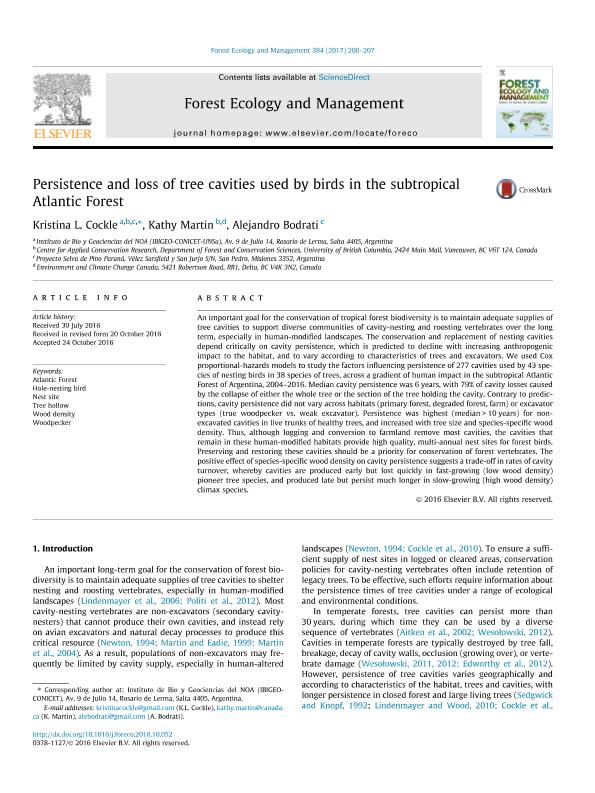Mostrar el registro sencillo del ítem
dc.contributor.author
Cockle, Kristina Louise

dc.contributor.author
Martin, Kathy
dc.contributor.author
Bodrati, Alejandro
dc.date.available
2018-06-19T20:09:19Z
dc.date.issued
2017-01-15
dc.identifier.citation
Cockle, Kristina Louise; Martin, Kathy; Bodrati, Alejandro; Persistence and loss of tree cavities used by birds in the subtropical Atlantic Forest; Elsevier Science; Forest Ecology and Management; 384; 15-1-2017; 200-207
dc.identifier.issn
0378-1127
dc.identifier.uri
http://hdl.handle.net/11336/49445
dc.description.abstract
An important goal for the conservation of tropical forest biodiversity is to maintain adequate supplies of tree cavities to support diverse communities of cavity-nesting and roosting vertebrates over the long term, especially in human-modified landscapes. The conservation and replacement of nesting cavities depend critically on cavity persistence, which is predicted to decline with increasing anthropogenic impact to the habitat, and to vary according to characteristics of trees and excavators. We used Cox proportional-hazards models to study the factors influencing persistence of 277 cavities used by 43 species of nesting birds in 38 species of trees, across a gradient of human impact in the subtropical Atlantic Forest of Argentina, 2004–2016. Median cavity persistence was 6 years, with 79% of cavity losses caused by the collapse of either the whole tree or the section of the tree holding the cavity. Contrary to predictions, cavity persistence did not vary across habitats (primary forest, degraded forest, farm) or excavator types (true woodpecker vs. weak excavator). Persistence was highest (median > 10 years) for non-excavated cavities in live trunks of healthy trees, and increased with tree size and species-specific wood density. Thus, although logging and conversion to farmland remove most cavities, the cavities that remain in these human-modified habitats provide high quality, multi-annual nest sites for forest birds. Preserving and restoring these cavities should be a priority for conservation of forest vertebrates. The positive effect of species-specific wood density on cavity persistence suggests a trade-off in rates of cavity turnover, whereby cavities are produced early but lost quickly in fast-growing (low wood density) pioneer tree species, and produced late but persist much longer in slow-growing (high wood density) climax species.
dc.format
application/pdf
dc.language.iso
eng
dc.publisher
Elsevier Science

dc.rights
info:eu-repo/semantics/openAccess
dc.rights.uri
https://creativecommons.org/licenses/by-nc-nd/2.5/ar/
dc.subject
Atlantic Forest
dc.subject
Hole-Nesting Bird
dc.subject
Nest Site
dc.subject
Tree Hollow
dc.subject
Wood Density
dc.subject
Woodpecker
dc.subject.classification
Otras Ciencias Biológicas

dc.subject.classification
Ciencias Biológicas

dc.subject.classification
CIENCIAS NATURALES Y EXACTAS

dc.title
Persistence and loss of tree cavities used by birds in the subtropical Atlantic Forest
dc.type
info:eu-repo/semantics/article
dc.type
info:ar-repo/semantics/artículo
dc.type
info:eu-repo/semantics/publishedVersion
dc.date.updated
2018-05-23T13:33:59Z
dc.journal.volume
384
dc.journal.pagination
200-207
dc.journal.pais
Países Bajos

dc.journal.ciudad
Amsterdam
dc.description.fil
Fil: Cockle, Kristina Louise. Consejo Nacional de Investigaciones Científicas y Técnicas. Centro Científico Tecnológico Conicet - Salta. Instituto de Bio y Geociencias del NOA. Universidad Nacional de Salta. Facultad de Ciencias Naturales. Museo de Ciencias Naturales. Instituto de Bio y Geociencias del NOA; Argentina. University of British Columbia; Canadá. Proyecto Selva de Pino Paraná; Argentina
dc.description.fil
Fil: Martin, Kathy. University of British Columbia; Canadá. Proyecto Selva de Pino Paraná; Argentina
dc.description.fil
Fil: Bodrati, Alejandro. Proyecto Selva de Pino Paraná; Argentina
dc.journal.title
Forest Ecology and Management

dc.relation.alternativeid
info:eu-repo/semantics/altIdentifier/doi/http://dx.doi.org/10.1016/j.foreco.2016.10.052
dc.relation.alternativeid
info:eu-repo/semantics/altIdentifier/url/https://www.sciencedirect.com/science/article/pii/S0378112716308738
Archivos asociados
